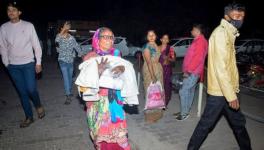UP Elections: Permanent Houses Still Far Cry in Sonbhadra Villages Despite Modi’s ‘Lakhpati’ Claim
Sonbhadra: A few days before polling kicked off in Uttar Pradesh (UP) last month, Prime Minister Narendra Modi made the staggering claim of providing permanent houses to three crore poor people under the Pradhan Mantri Awas Yojana (PMAY) in the last seven years of the Bharatiya Janata Party rule, turning them into “lakhpatis” (millionaires).
However, the ground reality in the hinterland of UP’s Sonbhadra district suggests otherwise. Struggling to make ends meet, the natives have neither got permanent houses nor are millionaires.
Out of the total 800 houses in Sendur Gram Panchayat, in the Obra (reserved) Assembly segment—comprising three revenue villages Makara, Labhari and Sendur—only 250 are concrete structures. The panchayat has a population of around 7,05,000 with a majority of them belonging to Scheduled Tribes and also Scheduled Castes and Other Backward Classes.
While 100 houses were constructed under PMAY, former pradhan Ram Bhagat told Newsclick, the rest were built under the Indira Awas Yojna, renamed as Pradhan Mantri Gramin Awas Yojana.
These villages lack even basic infrastructure, such as roads, potable water, irrigation, toilets, effective healthcare and schools imparting quality education. Geographically, these are hilly regions where water is deficient. Though the country’s largest artificial lake, the Rihand Dam (also known as Govind Ballabh Pant Sagar), is located close to these villages at Pipri, it does not have a network of canals to divert the water to the agricultural fields.
Farming in this region is solely dependent on rainfall—if it rains, farmers get yield; otherwise, their entire crop is destroyed. There are three wells each in Labhari and Sendur and eight in Makara to cater for farming. “Where there is no well, farming is dependent on God’s mercy,” Bhagat said.
Besides the main crops of maze, pigeon pea and sesame, wheat and paddy are also grown in some areas—but the yield is too low due to water deficiency. Not more than 10 farmers who own big pieces of land and are comparatively well-off manage to produce more than their household consumption.
Due to the groundwater depth ranging between 80 feet and 200 feet—around 50 feet in areas that are in proximity of waterbodies—poor farmers are unable to pump it out through deep boring, which costs around Rs 1 lakh or more.
According to villagers, either they don’t get the benefits of government schemes like old-age pension, widow pension or handicap allowance or the amount is never credited on time. “Except the PM Kisan Samman Nidhi, payment under other schemes is credited to their accounts in either six months or a year,” Bhagat said. “Almost all those who have valid documents to show their title over the land they cultivate get the sum in three instalments.”
Out of the 50 widows in the three villages, only 28-30 get the pension—that too after months. Similarly, only 300-400 villagers get an old-age pension amounting to not more than Rs 500.
The respite of the villagers is the free supply of five kg of rice and wheat, one kg of gram and salt and one litre of refined oil twice a month for free under the Public Distribution System. “This is the backbone of the villagers. With uncertainly always looming over farming, they will starve to death if they don’t get free ration,” Bhagat said.
Since payment for work done under the Mahatma Gandhi National Rural Employment is made after months or even a year, villagers are least interested in it, especially with the daily wage as low as Rs 250.
“Every time I enquire from the pradhan about my dues, I get a one-line reply, ‘It’s under process’,” Ajay Prajapati, who had worked for around 10 days in the construction of a nearby interlocking road a year ago but is still awaiting payment, told Newsclick.
In the absence of basic infrastructure, a family becomes heavily indebted if a member falls sick. “The primary health centre at Makara has only one doctor who is hardly there. We buy costly medicines from outside. The community health centre and the district hospital are far. The state government makes tall claims that ambulance facility is available round the clock, but they never transport serious patients from these villages. The corrupt staff of the district hospital treats patients like animals. Left with no option, we depend on private healthcare,” Bhagat said.
Thousands of villagers in Sonbhadra, according to local activist Dinkar Kapoor, stay in pitiable conditions amid the fear of monsoons. “Thousands of hapless villagers are filling forms to get their roofs repaired but will end up taking huge loans to repair their houses. PMAY seems like a dummy programme of the government meant to fool the public,” he told Newsclick adding that roofs often collapse.
Kapoor, who has been working for the upliftment of the marginalised, said that if the government is “so serious about giving benefits to people under PMAY in rural areas, the scheme should be available throughout the year or, at least, once a month”.
Ironically, these areas are most neglected despite the local MLA Sanjeev Gond being the minister for social welfare in the Yogi Adityanath government.
Get the latest reports & analysis with people's perspective on Protests, movements & deep analytical videos, discussions of the current affairs in your Telegram app. Subscribe to NewsClick's Telegram channel & get Real-Time updates on stories, as they get published on our website.






















